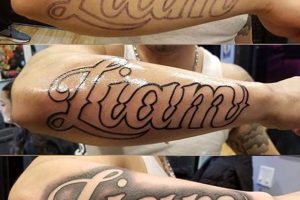Selecting the location for a name tattoo involves careful consideration of various factors, including the name’s length, font style, and the desired level of visibility. For instance, a small, delicate script featuring a child’s name might be suitable for the wrist, while a larger, bolder design honoring a loved one could be placed on the back or chest. The placement choice significantly impacts the tattoo’s overall aesthetic and personal meaning.
Thoughtful placement enhances the artistry of body art and imbues it with deeper significance. Historically, the location of a tattoo often held cultural or symbolic weight. Today, individuals choose locations based on personal preference, desired visibility, and how the placement complements the body’s natural contours. This deliberate choice allows the tattoo to become a seamless and meaningful part of one’s personal narrative.
Exploring placement options requires considering factors such as pain tolerance, body changes over time, and professional advice. The following sections delve into specific areas of the body suitable for name tattoos, offering detailed insights and inspiring examples to guide informed decisions.
Tips for Choosing Name Tattoo Placements
Selecting an appropriate location for a name tattoo requires careful planning. These tips offer guidance for making informed decisions that result in aesthetically pleasing and personally meaningful body art.
Tip 1: Consider Size and Style: Intricate script and longer names require more surface area. Smaller placements, such as the wrist or ankle, suit shorter names or initials. Larger designs can be accommodated on areas like the back, chest, or thigh.
Tip 2: Factor in Visibility: Highly visible areas like the hands and neck make a bold statement. More discreet placements, such as the ribs or inner arm, offer privacy and subtlety.
Tip 3: Research Pain Levels: Certain areas, like the ribs or feet, are known to be more sensitive. Research pain levels associated with different locations and choose accordingly.
Tip 4: Anticipate Body Changes: Areas prone to significant weight fluctuations or stretching, such as the stomach, may distort the tattoo over time. Opt for locations less susceptible to change.
Tip 5: Consult with a Professional: Experienced tattoo artists offer valuable insights into placement, design, and aftercare. Consultations help ensure informed decisions aligned with individual preferences and body types.
Tip 6: Reflect on Personal Meaning: The chosen location should resonate with the significance of the name. Consider the relationship and the desired level of intimacy or public display.
Tip 7: Explore Visual Examples: Browsing online galleries and portfolios provides inspiration and helps visualize different placements on various body types. This visual research can clarify preferences and inform design choices.
Careful consideration of these factors leads to well-placed body art that holds lasting personal meaning. Thoughtful placement ensures the tattoo remains a source of pride and a beautiful expression of personal identity.
By understanding these crucial considerations, individuals can approach the process with confidence and make informed decisions that result in a cherished piece of body art.
1. Size and Font
The interplay between size and font significantly influences the aesthetic and practical aspects of name tattoos. Script intricacy and name length dictate the minimum canvas size required. Elaborate calligraphy, for instance, demands more space than a simple sans-serif font. A longer name necessitates a larger area or a smaller font size. Placement must accommodate these factors; a small wrist tattoo limits font choices and name length, while a larger back piece allows for greater flexibility. Choosing an appropriate size and font ensures the design remains legible and aesthetically pleasing over time.
Consider the desired visual impact. A delicate, small font conveys intimacy and subtlety, often chosen for placements like the inner wrist or behind the ear. Conversely, a bold, large font projects strength and confidence, suitable for prominent placements such as the forearm or chest. The font itself carries meaning; elegant scripts evoke classicism, while modern fonts suggest contemporary sensibilities. This interplay between size, font, and placement allows for personalized expression and visual storytelling.
Practical considerations are paramount. Smaller fonts become less legible as they age, potentially blurring intricate details. Larger fonts offer greater longevity and clarity. The chosen font and its size directly affect placement possibilities. Detailed discussions with a skilled tattoo artist are crucial to ensure the chosen design elements harmonize with the desired placement and body contours. Ultimately, a balanced relationship between size, font, and placement ensures a successful and meaningful tattoo.
2. Visibility and Discretion
The decision of whether to display a name tattoo prominently or keep it concealed is a crucial aspect of placement strategy. Visibility and discretion influence how the tattoo interacts with personal and professional life, impacting its perceived meaning and social implications.
- Public Display and Personal Expression
Highly visible placements, such as the hands, neck, or face, make bold statements about personal identity and relationships. These locations prioritize public display and readily convey the significance of the name to the world. Choosing a visible placement often signifies a desire to openly celebrate a relationship or honor a loved one. However, societal perceptions and professional contexts should be considered, as highly visible tattoos can still face stigma in some environments.
- Private Remembrance and Intimate Connection
Discreet placements, like the ribs, inner thigh, or back, offer privacy and intimacy. These hidden locations allow individuals to carry a deeply personal tribute without the need for public display. The tattoo becomes a private reminder of a cherished relationship or a source of personal strength, visible only to select individuals. This level of discretion allows for a more intimate connection with the tattoo’s meaning.
- Professional Considerations and Social Contexts
Certain professions maintain stricter dress codes that may restrict visible tattoos. Choosing a discreet placement allows individuals to comply with professional guidelines while still expressing themselves through body art. Societal norms also influence perceptions of visible tattoos. While acceptance is growing, considering potential social implications remains relevant when deciding on placement.
- Balancing Visibility with Personal Comfort
Ultimately, the balance between visibility and discretion depends on individual preferences and lifestyle. Some individuals may prefer a partially concealed tattoo, visible only in certain clothing or situations. This approach allows for a degree of personal expression while maintaining flexibility in different social and professional contexts.
The spectrum between visibility and discretion offers a range of options to align with individual needs and preferences. Careful consideration of these factors ensures the chosen placement resonates with the individual’s lifestyle and the intended message of the tattoo, allowing it to serve as a powerful and meaningful form of personal expression.
3. Body Contours
Effective placement harmonizes a tattoo with the body’s natural curves and musculature. Body contours influence how a design flows and ages, impacting both aesthetics and legibility over time. Understanding these contours is crucial for successful name tattoo placement.
- Musculature and Flow
Muscles define the body’s landscape, impacting how a tattoo appears in different positions and movements. Placement should complement muscle lines, allowing the design to flow naturally with the body. Names placed along the contours of biceps, calves, or back muscles create an integrated and visually appealing aesthetic. Conversely, placements that disrupt natural muscle lines may appear distorted or fragmented.
- Curves and Placement Considerations
The body’s natural curves provide both opportunities and challenges for tattoo placement. Curved areas like the shoulder, hip, or ribcage require careful design adaptation. A skilled artist can use these curves to enhance the tattoo’s flow, creating a sense of movement and dimension. However, poorly planned placements on curved surfaces can lead to distortion as the body moves or ages. Proper planning ensures the tattoo remains aesthetically pleasing from all angles.
- Long-Term Changes and Placement Longevity
Bodies change over time due to factors such as aging, weight fluctuations, and pregnancy. Areas prone to significant change, like the abdomen or upper arms, may distort tattoos over time. Choosing locations less susceptible to change, like the collarbone or forearm, helps preserve the tattoo’s integrity and legibility. Anticipating potential changes ensures the design remains aesthetically pleasing for years to come.
- Placement and Visual Impact
Body contours influence how a tattoo interacts with clothing and movement, impacting its overall visual impact. Placements that follow natural lines create a seamless integration with the body, enhancing the design’s flow and elegance. Conversely, placements that disrupt these lines can appear jarring or out of place. Careful consideration of body contours ensures the tattoo complements the individual’s physique and enhances their personal style.
Ultimately, successful name tattoo placement requires a deep understanding of how body contours interact with design elements. By considering musculature, curves, potential long-term changes, and desired visual impact, individuals can choose locations that enhance both the aesthetic appeal and longevity of their tattoos, ensuring a meaningful and visually stunning piece of body art.
4. Pain Tolerance
Pain tolerance is a critical factor in choosing a tattoo placement. Discomfort levels vary significantly across body areas, influencing decisions regarding design complexity, session length, and overall tattoo experience. Understanding pain sensitivity related to placement helps individuals make informed choices and manage expectations realistically.
- Individual Variability
Pain perception is subjective, influenced by individual thresholds, previous experiences, and overall physical and mental state. While general guidelines exist regarding more sensitive areas, individual reactions vary considerably. Factors like sleep, hydration, and emotional state can further influence discomfort levels during the tattooing process. Open communication with the tattoo artist about personal pain tolerance facilitates a more comfortable and manageable experience.
- Location Sensitivity
Certain areas, such as the ribs, armpits, inner elbows, groin, ankles, feet, and nipples, are generally considered more sensitive due to thinner skin, increased nerve endings, or proximity to bone. Areas with more muscle or fat, such as the outer thighs, outer arms, and back, tend to be less sensitive. Considering location sensitivity helps individuals anticipate potential discomfort and choose placements accordingly.
- Tattoo Size and Complexity
Larger, more complex designs require longer sessions, increasing overall discomfort regardless of placement. Individuals with lower pain tolerance might opt for smaller designs or break larger pieces into multiple sessions. This strategic approach allows for breaks and minimizes prolonged exposure to discomfort, making the experience more manageable.
- Pain Management Techniques
Various techniques can help manage discomfort during tattooing. Deep breathing exercises, over-the-counter pain relievers (consult a doctor beforehand), and topical numbing creams (with artist approval) may offer some relief. Experienced artists employ techniques to minimize discomfort, such as strategically scheduling breaks and adjusting needle depth. Open communication with the artist regarding pain management preferences contributes to a more positive overall experience.
By considering individual pain tolerance alongside desired design and placement, individuals can approach the tattooing process with realistic expectations. Open communication with the artist, combined with appropriate pain management strategies, ensures a more comfortable and ultimately more fulfilling experience, resulting in a cherished piece of body art.
5. Long-Term Changes
The human body undergoes inevitable transformations over time. These changes, influenced by aging, weight fluctuations, pregnancy, and lifestyle factors, significantly impact the longevity and aesthetic appeal of tattoos. Considering potential long-term changes is crucial when selecting a placement for a name tattoo, ensuring the design remains visually pleasing and legible for years to come. Ignoring these factors can lead to distorted or faded tattoos, diminishing the intended artistic expression and personal significance.
Skin elasticity decreases with age, potentially leading to sagging and wrinkling. Placements on areas prone to significant elasticity changes, such as the stomach, chest, and inner thighs, are more susceptible to distortion over time. Conversely, areas that maintain relative stability, such as the forearm, outer thigh, or shoulder blade, offer better long-term canvas integrity. Weight fluctuations can stretch or shrink the skin, impacting the tattoo’s shape and clarity. Placements on areas prone to weight changes, like the abdomen or upper arms, require careful consideration. Pregnancy also stretches the skin significantly, particularly around the abdomen and hips, potentially distorting tattoos in these areas. Choosing placements less affected by pregnancy-related changes helps preserve the design’s original form.
Understanding the interplay between long-term body changes and tattoo placement empowers informed decision-making. Consulting with experienced tattoo artists provides valuable insights into placement longevity and design adaptability. Artists can suggest appropriate placements, font choices, and design elements that minimize the impact of future body changes. This proactive approach ensures the tattoo remains a source of pride and personal expression throughout life’s various stages, preserving its intended artistic and emotional significance.
6. Symbolic Meaning
Placement choice for a name tattoo extends beyond aesthetics, often imbued with symbolic meaning. Specific locations on the body can amplify the emotional resonance and personal significance of the inscribed name, transforming the tattoo into a powerful statement of identity, love, remembrance, or personal values. Understanding these symbolic connections allows individuals to make informed placement decisions that deepen the tattoo’s meaning.
- Placement Over the Heart
Positioning a name directly over the heart symbolizes deep love, devotion, and an enduring emotional connection. This placement signifies that the individual holds the named person close to their heart, both literally and figuratively. It represents a profound and intimate bond, often chosen to honor a significant other, a beloved family member, or a cherished friend. This placement prioritizes emotional significance over public visibility, reflecting the deeply personal nature of the relationship.
- Placement on the Wrist
The wrist, a prominent yet accessible location, serves as a constant reminder of the named individual. This placement suggests a close bond and readily displays the name, signifying a willingness to share the relationship with the world. Historically, the wrist has been associated with vulnerability and emotional expression, adding another layer of symbolic meaning to names placed in this area. Additionally, the pulse point’s proximity can further symbolize the life-giving connection to the named person.
- Placement on the Forearm
The forearm, often associated with strength and protection, can symbolize a desire to safeguard the named individual or to draw strength from their memory. This visible placement also demonstrates pride and openly declares the importance of the relationship. Names tattooed on the forearm can serve as a source of inspiration or a reminder of shared experiences, further reinforcing the bond between the wearer and the named individual. The forearm’s visibility also suggests a desire to share this connection with the world.
- Placement on the Back
The back, a broad and less visible canvas, offers a sense of privacy and personal reflection. Names placed on the back can represent a deeply personal connection, perhaps symbolizing a supportive foundation or a guiding presence in one’s life. The back’s size also accommodates larger, more intricate designs, allowing for greater artistic expression. The relative permanence of back tattoos further underscores the enduring nature of the relationship or memory being honored.
By considering the symbolic meanings associated with various placements, individuals can imbue their name tattoos with deeper emotional resonance. Thoughtful placement elevates the tattoo beyond a simple inscription, transforming it into a powerful and personal symbol of love, remembrance, and enduring connection. This intentional approach ensures the tattoo becomes a meaningful and cherished piece of art, reflecting the profound significance of the name it bears.
Frequently Asked Questions about Name Tattoo Placement
Careful placement ensures a name tattoo remains a source of pride and personal expression. This section addresses common queries regarding placement considerations.
Question 1: What are the most popular placement choices for name tattoos?
Popular placements include the wrist, forearm, inner bicep, ribs, ankle, and back. Ultimately, the ideal placement depends on individual preferences regarding visibility, size, and personal significance.
Question 2: How does pain tolerance factor into placement decisions?
Areas with thinner skin and closer proximity to bone, such as ribs, ankles, and inner wrists, tend to be more sensitive. Individuals with lower pain thresholds should consider placements with more muscle or fat padding, like the outer thigh or upper arm.
Question 3: How might a name tattoo age over time, and how does placement affect this?
Skin loses elasticity with age, potentially impacting tattoo clarity. Placements on areas prone to stretching or sagging, like the stomach or inner thighs, may experience greater distortion. More stable areas, like the forearm or shoulder blade, generally maintain better long-term visual integrity.
Question 4: Can placement enhance the symbolic meaning of a name tattoo?
Placement can significantly enhance symbolic meaning. A name over the heart signifies deep love, while a wrist placement offers a constant reminder. Forearm placements can represent strength and protection, whereas names on the back often symbolize a supportive presence.
Question 5: How do professional considerations influence placement choices?
Workplace dress codes often restrict visible tattoos. Individuals in such professions might opt for easily concealed placements, like the back, ribs, or inner thighs. Considering career implications ensures the tattoo remains a personal expression without hindering professional opportunities.
Question 6: How important is consulting with a tattoo artist about placement?
Consulting with an experienced artist is crucial. Artists provide personalized guidance based on individual preferences, body type, and design elements. Their expertise ensures informed decisions regarding placement, size, font, and overall aesthetic harmony.
Careful consideration of these factors ensures informed placement decisions that result in meaningful and enduring body art. Prioritizing individual preferences, pain tolerance, and long-term changes helps create a tattoo that resonates with personal style and symbolic significance.
Ready to explore specific placement ideas? The next section provides a detailed gallery showcasing various options for name tattoos.
Conclusion
Selecting appropriate placement for a name tattoo requires careful consideration of multiple factors. Design elements, including size, font, and style, must harmonize with the chosen location. Individual pain tolerance influences placement decisions, alongside anticipated long-term body changes and desired levels of visibility. Symbolic meaning further enriches placement choices, transforming body art into a powerful statement of personal connection. Ultimately, a well-chosen placement ensures the tattoo remains a cherished and meaningful expression of personal identity.
Permanent body art demands thoughtful consideration. Decisions regarding placement reflect individual narratives and aesthetic sensibilities. Consultation with experienced professionals ensures informed choices that respect both the artistry of tattooing and the enduring power of names. Careful planning transforms a name tattoo into a timeless piece of personal expression, reflecting a deep and lasting connection.







